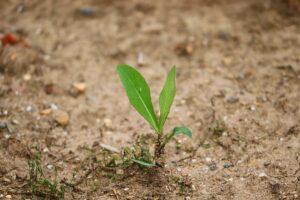A drying country, lacking answers – agriculture is one of the biggest domestic victims of climate change
The drought experienced in recent years continued in 2025, which again did not leave domestic agriculture untouched. While greenhouse gas emissions in this sector have decreased, we can see a rather unfavorable picture in terms of adaptation to the effects of climate change. Domestic developments are also shed new light on the European Environment Agency’s (EEA) report on the state of the EU environment. Analysis by Levente András Koczóh, senior climate policy expert at the Green Policy Center.
 The European Environment Agency’s (EEA) report entitled “Europe’s Environment 2025” sheds new light on the situation of Hungarian agriculture, in which, although greenhouse gas emissions have decreased, the picture in terms of adaptation to climate change is unfavorable. The EEA report emphasizes that Hungary’s climate is warming faster than the global average, and in parallel, the frequency of extreme weather events is increasing.
The European Environment Agency’s (EEA) report entitled “Europe’s Environment 2025” sheds new light on the situation of Hungarian agriculture, in which, although greenhouse gas emissions have decreased, the picture in terms of adaptation to climate change is unfavorable. The EEA report emphasizes that Hungary’s climate is warming faster than the global average, and in parallel, the frequency of extreme weather events is increasing.
Complementing the report with data from the Central Statistical Office, it turns out that in three out of four years between 2021 and 2024, at least 70% of the country’s territory was affected by drought. In comparison, this only happened seven times in the previous twenty years. In addition to warming, water shortages are also worsening, as the water yield of rivers entering our country has decreased by 15% and the groundwater level has decreased by more than four Balatons.
Agriculture is one of the sectors most sensitive to climate change. Although the sector’s GHG emissions have decreased – in 2023, 9% less greenhouse gases were released into the atmosphere, and fertilizer use has also fallen to half the 2021 level – Hungary has lagged behind in terms of adaptation. Organic farming is characteristic of only 6.3% of the cropland, while the EU average is 9.1% and the target is 25% by 2030. This lag indicates systemic problems: the main problem is not emissions, but the fact that the structure of agriculture is not adapting to the changing climate.
Water scarcity is no longer a natural phenomenon, but a structural crisis
According to the Green Policy Center’s Second Climate Adaptation Progress Report – which also takes into account the drought damage of 2021-2024 – the yields of corn, sunflower, wheat, and barley have also been blatantly weak in recent years, but despite the challenges, we continue to grow crops that are sensitive to drought on an ever-increasing area.
However, the Hungarian water management is undergoing dramatic changes. Compared to 30 years ago, the rate of evaporation has doubled, while the amount of precipitation is decreasing. The Southern and Central Great Plains are particularly vulnerable, but groundwater depletion is a nationwide phenomenon: 3.5 Balatons worth of water have disappeared from the soil in the Tisza catchment area, and one Balaton along the Danube. In some places, tree roots no longer reach the groundwater.
The severity of the situation is clearly demonstrated by the fact that the financial value of drought damage is now twenty times that of flood damage. While previously an abundance of water caused problems, today water scarcity is the main problem – while water management is still based on drainage, not retention. The development of water retention infrastructure began in earnest this year, for example with the 288 billion forint budget of the “Water into the Landscape!” program, but its impact is still limited.
Irrigation is not a general solution either. Illegal water withdrawal in some regions is several times higher than official figures, and legal irrigation affects only 3–4% of agricultural land. According to the Green Policy Center expert, “climate change adaptation at the national level depends less on the development of irrigation, as its possibilities are limited”. It is much more important to keep rainwater in place, increase the water retention capacity of the soil, and transform landscape use.
There is no future without a revolution
According to Levente András Koczóh, the key to a more sustainable future is a systemic change in perspective. This has three main pillars: the transformation of water management, the structural renewal of crop production, and the rearrangement of economic incentives.
In water management, it is essential to spread mulching and no-till farming, because they reduce evaporation and improve soil structure. Keeping flood and inland waters in place instead of surface drainage is the cheapest and most natural water retention solution. If irrigation is to be used, it must be implemented in a sustainable way, based on renewable energy sources.
The future of crop production belongs to drought-tolerant varieties. Sorghum has already appeared in Hungary, and more and more farmers are experimenting with fruits that were previously unthinkable – for example, figs, kiwis, and even bananas on the southern shore of Lake Balaton. This also shows how much the climate has changed.
In animal husbandry, problems caused by heat stress have become decisive: high temperatures reduce milk yield and fertility, so protecting grazing animals – for example by creating wooded pastures – is a matter of life and death.
Related news
Apples have become significantly more expensive in Hungary
🎧 Hallgasd a cikket: Lejátszás Szünet Folytatás Leállítás Nyelv: Auto…
Read more >Despite the drought, there will be no shortage of high-quality Hungarian fish
🎧 Hallgasd a cikket: Lejátszás Szünet Folytatás Leállítás Nyelv: Auto…
Read more >KSH: industrial production decreased by 2.7 percent in October compared to the same period of the previous year, and increased by 0.5 percent compared to the previous month
🎧 Hallgasd a cikket: Lejátszás Szünet Folytatás Leállítás Nyelv: Auto…
Read more >Related news
Bread and wine for 399 forints, mulled wine for 450 forints: ALDI opens its own downtown Christmas market
🎧 Hallgasd a cikket: Lejátszás Szünet Folytatás Leállítás Nyelv: Auto…
Read more >MBH Analysis Center: Hungarian tourism is soaring – further growth is expected in the hotel market
🎧 Hallgasd a cikket: Lejátszás Szünet Folytatás Leállítás Nyelv: Auto…
Read more >It’s really worth coming together: Lidl and its customers make Christmas more beautiful for 2,000 disadvantaged children
🎧 Hallgasd a cikket: Lejátszás Szünet Folytatás Leállítás Nyelv: Auto…
Read more >






